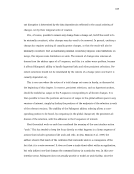121
tion�operations,�and�also�used�to�track�the�relative�positions�of�significant�addresses,�which
are�used�in�address�comparison.�The�comparison�of�addresses�is�discussed�in�Section�6.7.1.
The�application�strategy�discussed�in�Section�3.4.2a�allows�applications�to�increase�merge
possibilities�by�automatically�translating�destination�addresses�within�move�results�to�their
ultimate�source.�Such�an�address�has�the�form�(I
1 …I
n , i),�whereI
1 …I
n–1 are�moves�or�copies,
and�I
n is�an�insertion�operation.�Such�a�destination�is�stored�as�if�it�were�inserted�at�(I
n , i),
to�ease�the�traversal�of�a�P-sequence.�The�altered�location�correctly�reflects�its�ordering�with
respect�to�the�other�data�within�the�moved�or�copied�context.�The�insertion�point,�and�its
actual�address,�(I
1 …I
n , i)must�also�be�indexed�in�their�correct�relative�position�for�address
comparison.
Inserted�data�is�represented�by�a�logical�list�of�subsequence�segments.�Each�segment�is
tagged�with�its�insertion�of�origin.�When�data�is�inserted�into�the�middle�of�a�segment,�that
segment�is�split,�and�the�new�data�is�tagged�with�its�own�insertion�tag.�The�first�segment�of
any�insertion�maintains�a�pointer�to�its�last�segment.�This�allows�an�absent�insertion�to�be
quickly�traversed,�since�no�data�inserted�inside�of�it�can�be�present�in�a�version�from�which
it�is�absent.�This�trick�for�sequential�enumeration�of�segments�essentially�skips�any�inserted
segments�that�are�causally�than�an�insertion�not�present�in�the�version�of�interest.
Segments�inserted�into�post-move�or�post-copy�contexts�will�have�been�translated�back-
wards�to�the�sources�of�their�context-defining�operations.�They�are�additionally�tagged�with
the�ID�of�the�move�or�copy�changes�to�indicate�that�they�are�only�valid�within�the�destina-
tion�region�of�a�particular�set�of�move�or�copy�operations.�When�encountered�in�other�con-
texts�they�are�ignored,�just�like�ones�that�are�not�part�of�the�current�version.�This�structure
also�contains�point�markers�representing�the�destinations�of�move�and�copy�operations,
whose�IDs�allow�their�source�regions�to�be�determined.�These�are�essentially�transclusion
links�in�the�sense�of�(Nelson�1987;�Nelson�1987).�They�represent�the�transparent�inclusion�of
material�stored�elsewhere.�When�traversing�a�segment�list�to�enumerate�the�contents�of�a�P-
tion�operations,�and�also�used�to�track�the�relative�positions�of�significant�addresses,�which
are�used�in�address�comparison.�The�comparison�of�addresses�is�discussed�in�Section�6.7.1.
The�application�strategy�discussed�in�Section�3.4.2a�allows�applications�to�increase�merge
possibilities�by�automatically�translating�destination�addresses�within�move�results�to�their
ultimate�source.�Such�an�address�has�the�form�(I
1 …I
n , i),�whereI
1 …I
n–1 are�moves�or�copies,
and�I
n is�an�insertion�operation.�Such�a�destination�is�stored�as�if�it�were�inserted�at�(I
n , i),
to�ease�the�traversal�of�a�P-sequence.�The�altered�location�correctly�reflects�its�ordering�with
respect�to�the�other�data�within�the�moved�or�copied�context.�The�insertion�point,�and�its
actual�address,�(I
1 …I
n , i)must�also�be�indexed�in�their�correct�relative�position�for�address
comparison.
Inserted�data�is�represented�by�a�logical�list�of�subsequence�segments.�Each�segment�is
tagged�with�its�insertion�of�origin.�When�data�is�inserted�into�the�middle�of�a�segment,�that
segment�is�split,�and�the�new�data�is�tagged�with�its�own�insertion�tag.�The�first�segment�of
any�insertion�maintains�a�pointer�to�its�last�segment.�This�allows�an�absent�insertion�to�be
quickly�traversed,�since�no�data�inserted�inside�of�it�can�be�present�in�a�version�from�which
it�is�absent.�This�trick�for�sequential�enumeration�of�segments�essentially�skips�any�inserted
segments�that�are�causally�than�an�insertion�not�present�in�the�version�of�interest.
Segments�inserted�into�post-move�or�post-copy�contexts�will�have�been�translated�back-
wards�to�the�sources�of�their�context-defining�operations.�They�are�additionally�tagged�with
the�ID�of�the�move�or�copy�changes�to�indicate�that�they�are�only�valid�within�the�destina-
tion�region�of�a�particular�set�of�move�or�copy�operations.�When�encountered�in�other�con-
texts�they�are�ignored,�just�like�ones�that�are�not�part�of�the�current�version.�This�structure
also�contains�point�markers�representing�the�destinations�of�move�and�copy�operations,
whose�IDs�allow�their�source�regions�to�be�determined.�These�are�essentially�transclusion
links�in�the�sense�of�(Nelson�1987;�Nelson�1987).�They�represent�the�transparent�inclusion�of
material�stored�elsewhere.�When�traversing�a�segment�list�to�enumerate�the�contents�of�a�P-





























































































































































































